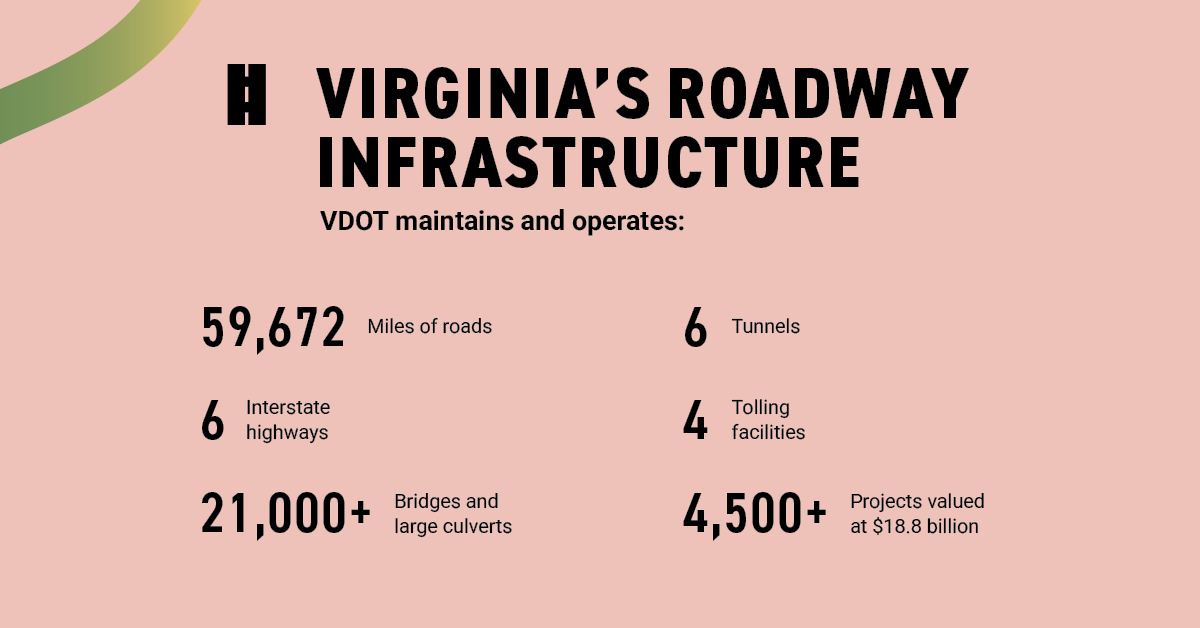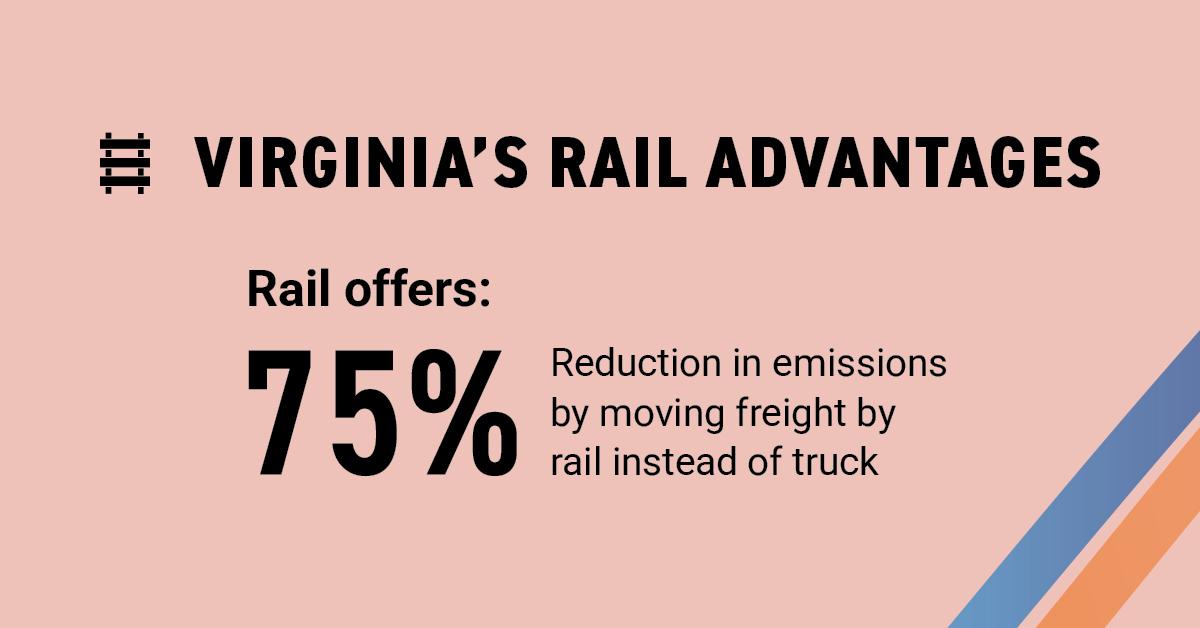Built to Deliver
Virginia’s infrastructure investments underpin business resiliency
Connections are an essential foundation of business success — and businesses trust Virginia’s infrastructure to provide a multimodal transportation system that reliably connects them to suppliers, customers, and partners. The Commonwealth is home to one of the East Coast’s top seaports, four major cargo service airports, 12 freight railroads and more than 3,000 miles of freight rail, and some of the country’s most heavily traveled truck routes. More importantly, Virginia has a proactive stance on investing in improvements in the essential travel corridors that keep businesses connected.
It’s this emphasis on connectivity that drives many of the Virginia Department of Transportation’s (VDOT) more than 4,500 active improvement projects. “Virginia’s highway network provides a critical link in the larger highway system within the eastern United States, making it all the more essential that VDOT make continued investments in its safety and reliability,” said Catherine C. McGhee, P.E., chief deputy commissioner for VDOT.
Ongoing projects include work to add travel lanes and other improvements to the critical north-south backbone of the East Coast’s freight network. Nearly 50% of the state’s value of goods is transported along Interstate 81, which has the highest per capita truck volume in Virginia. VDOT reports that the corridor handles approximately $300 billion in goods and services each year. Continuous improvements are essential for ensuring the high degree of travel predictability on which businesses and freight haulers rely.
In addition, McGhee pointed out, “Widening Interstate 64 between Hampton Roads and Richmond will enhance connectivity and support movement to and from The Port of Virginia. Expanding our network of express lanes on Interstate 495 will reduce congestion in a region where population and employment opportunities continue to grow.”
This dense network is supported by a web of warehouses across the state. In the last three years alone, more than 30 million square feet of new and expanded warehouse space has been announced throughout Virginia, totaling an investment of more than $6 billion.
Travelers and shippers rely on the reliability afforded by these essential interstate connections. However, rail remains a leading conduit for cargo crossing Virginia because rail access reduces per-ton-mile shipping costs and minimizes reliance on long-haul trucking. The Association of American Railroads estimates it would take approximately 6.5 million trucks to handle the freight that moved by rail in Virginia in 2022. The Commonwealth is home to more than 3,000 miles of freight rail, all part of an ecosystem that offers direct service to points including Detroit, Chicago, and Kansas City. While this mileage puts the state at 21st in rail network size, the Virginia Department of Rail and Public Transportation (DRPT) notes that Virginia outperforms in terms of originating and terminating freight rail carloads. It comes in 13th for carload origin and 10th for carload termination.
To keep up with the growing rate of goods traveling by freight, The Port of Virginia has completed an $83 million investment in expanding its rail yard. With this expansion, the port positioned itself to move 2 million twenty-foot equivalent units (TEUs) of cargo in 2024, a 13% increase over its prior year capacity. Cargo at the port sees an average rail-ready dwell time — time spent at a scheduled stop without moving — of 32 hours.

Source: Virginia Department of Transportation
The port isn’t the only party investing in rail enhancements. Through its Transforming Freight in Virginia initiative, DRPT has plans for approximately 123 freight rail improvement projects through 2042. These projects, totaling approximately $536 million, aim to address bottlenecks impacting both passenger and freight rail operations. This includes investments in Class I railroads across the state to reduce capacity constraints, mitigate operational chokepoints, and increase efficiency.
Norfolk Southern Corporation points out that these investments help reduce per-ton-mile shipping costs and minimize reliance on long-haul trucking. The rail operator infrastructure is the backbone of its ability to deliver safe, timely, and cost-effective service. Investments in modern yards, intermodal terminals, and predictive maintenance systems help minimize delays and ensure consistent performance.
Norfolk Southern operates 1,990 miles of track across Virginia and works closely with state agencies to provide manufacturers with direct access to high-performance logistics infrastructure that supports growth and efficiency. The rail operator points to the Commonwealth Crossing Business Centre in Henry County as one of the most promising locations for leveraging freight efficiency to empower economic development.Norfolk Southern calls the industrial site a model of collaboration; it worked with state and local partners and industrial developers to create a 200-acre industrial site primed to attract quality businesses to the region.
CSX Transportation, the other major rail provider in the Commonwealth, operates nearly 2,000 miles of Virginia track to go with several other facilities. The company maintains a portfolio of about 1,000 rail-served sites and has launched the CSX Select Site program to identify, evaluate, and improve properties for industrial use.
Airport Expansions Enhance Efficiency
Virginia’s airports are also positioned to support upward movement in business and cargo travel. “A growing segment of Virginia’s business and economic growth arises from relationships with companies and government entities across the nation and around the world — and our airports provide the connectivity that helps drive all this business activity,” said Jack Potter, president and CEO of the Metropolitan Washington Airports Authority (MWAA).
Washington Dulles International Airport has seen, on average, 222 tons of cargo each year since 2021, and capacity continues to climb. For the second year, Dulles has been ranked as the fastest-growing international airport in America, MWAA reports. Over the next 15 years, MWAA plans to invest $9 billion in airport infrastructure to accommodate demand at Dulles and Ronald Reagan Washington National Airport. “The airports are a key factor in Virginia’s designation as a top state for business — which helps spur the growth of the airports,” Potter said.
A growing segment of Virginia’s business and economic growth arises from relationships with companies and government entities across the nation and around the world — and our airports provide the connectivity that helps drive all this business activity.
These capital investments aim to increase airport efficiency, benefiting customers and businesses alike. Projects include new gates and a Metrorail station at Dulles, which have led airlines to increase their nonstop flights from Dulles to destinations around the globe. They also include technology to move travelers more efficiently through the airport.
Queue Hub is an airport intelligence platform developed in-house by MWAA Labs to display live wait times at TSA security checkpoints at Ronald Reagan Washington National Airport. It is also in the testing phase at Dulles checkpoints. Real-time information is available in-terminal and online, providing business passengers with a useful planning tool.
Through integrations with TSA and Custom Border Protection systems, Queue Hub applies machine learning algorithms and custom AI models to automatically deploy resources to the right lanes at the right time to minimize bottlenecks. The technology has reduced security wait times by an estimated 15% since becoming operational in 2023. In the future, MWAA expects its AI investments to speed aircraft turnaround times for even greater efficiency.
Through this and other investments in efficiency, Virginia businesses gain added assurance that their people and goods can get to their destinations on time.

Source: U.S. Department of Transportation Federal Railway Administration, 2022


